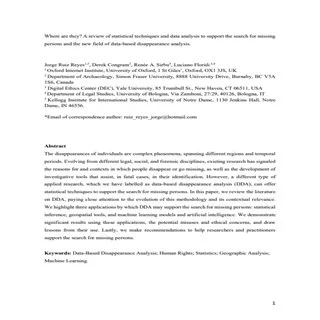By Jorge Ruiz Reyes, Derek Congram, Renée A. Sirbu, Luciano Floridi
The disappearances of individuals are complex phenomena, spanning different regions and temporal periods. Evolving from different legal, social, and forensic disciplines, existing research has signaled the reasons for and contexts in which people disappear or go missing, as well as the development of investigative tools that assist, in fatal cases, in their identification. However, a different type of applied research, which we have labelled as data-based disappearance analysis (DDA), can offer statistical techniques to support the search for missing persons. In this paper, we review the literature on DDA, paying close attention to the evolution of this methodology and its contextual relevance. We highlight three applications by which DDA may support the search for missing persons: statistical inference, geospatial tools, and machine learning models and artificial intelligence. We demonstrate significant results using these applications, the potential misuses and ethical concerns, and draw lessons from their use. Lastly, we make recommendations to help researchers and practitioners support the search for missing persons.
Unpublished paper 2024



